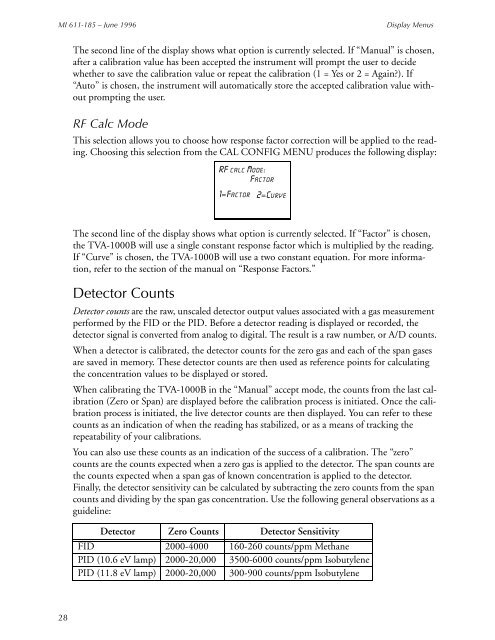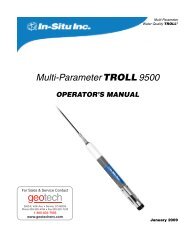Thermo Scientific TVA-1000B Instruction Manual - Geotech ...
Thermo Scientific TVA-1000B Instruction Manual - Geotech ...
Thermo Scientific TVA-1000B Instruction Manual - Geotech ...
Create successful ePaper yourself
Turn your PDF publications into a flip-book with our unique Google optimized e-Paper software.
MI 611-185 – June 1996<br />
Display Menus<br />
The second line of the display shows what option is currently selected. If “<strong>Manual</strong>” is chosen,<br />
after a calibration value has been accepted the instrument will prompt the user to decide<br />
whether to save the calibration value or repeat the calibration (1 = Yes or 2 = Again?). If<br />
“Auto” is chosen, the instrument will automatically store the accepted calibration value without<br />
prompting the user.<br />
RF Calc Mode<br />
This selection allows you to choose how response factor correction will be applied to the reading.<br />
Choosing this selection from the CAL CONFIG MENU produces the following display:<br />
RF calc Mode:<br />
Factor<br />
1=Factor 2=Curve<br />
The second line of the display shows what option is currently selected. If “Factor” is chosen,<br />
the <strong>TVA</strong>-<strong>1000B</strong> will use a single constant response factor which is multiplied by the reading.<br />
If “Curve” is chosen, the <strong>TVA</strong>-<strong>1000B</strong> will use a two constant equation. For more information,<br />
refer to the section of the manual on “Response Factors.”<br />
Detector Counts<br />
Detector counts are the raw, unscaled detector output values associated with a gas measurement<br />
performed by the FID or the PID. Before a detector reading is displayed or recorded, the<br />
detector signal is converted from analog to digital. The result is a raw number, or A/D counts.<br />
When a detector is calibrated, the detector counts for the zero gas and each of the span gases<br />
are saved in memory. These detector counts are then used as reference points for calculating<br />
the concentration values to be displayed or stored.<br />
When calibrating the <strong>TVA</strong>-<strong>1000B</strong> in the “<strong>Manual</strong>” accept mode, the counts from the last calibration<br />
(Zero or Span) are displayed before the calibration process is initiated. Once the calibration<br />
process is initiated, the live detector counts are then displayed. You can refer to these<br />
counts as an indication of when the reading has stabilized, or as a means of tracking the<br />
repeatability of your calibrations.<br />
You can also use these counts as an indication of the success of a calibration. The “zero”<br />
counts are the counts expected when a zero gas is applied to the detector. The span counts are<br />
the counts expected when a span gas of known concentration is applied to the detector.<br />
Finally, the detector sensitivity can be calculated by subtracting the zero counts from the span<br />
counts and dividing by the span gas concentration. Use the following general observations as a<br />
guideline:<br />
Detector Zero Counts Detector Sensitivity<br />
FID 2000-4000 160-260 counts/ppm Methane<br />
PID (10.6 eV lamp) 2000-20,000 3500-6000 counts/ppm Isobutylene<br />
PID (11.8 eV lamp) 2000-20,000 300-900 counts/ppm Isobutylene<br />
28

















